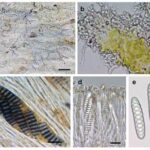New Delhi : A team of Indian scientists has discovered a previously unknown species of lichen—Allographa efusosoredica—from the Western Ghats, renowned for their biodiversity. This lichen serves as an example of symbiosis, evolution, and resilience. Lichens are not single organisms but rather a symbiotic partnership between two (sometimes more) organisms: a fungus that provides structure and protection, and a photobiont (typically a green alga or cyanobacterium) that produces food through photosynthesis. Despite their simple appearance, lichens play a critical role in ecosystems—forming soil, providing food for insects, and serving as bio-indicators of environmental health.
In a study conducted by the MACS-Agharkar Research Institute in Pune, an autonomous institution under India’s Department of Science and Technology (DST), traditional taxonomy was combined with modern molecular tools. This led to the establishment of new molecular markers for this species in the region. The newly identified species is a crustose lichen featuring attractive effuse soredia and relatively rare chemical characteristics, including the presence of a substance called norstictic acid, considered rare compared to other morphologically similar species in the Allographa genus. Detailed study of its morphology, chemical profile, and advanced molecular techniques also led to the identification of its algal partner—a Trentepohlia species—enhancing the understanding of photobiont diversity in tropical lichens, which is both sparse and expanding.
The research team noted, “This is the first Indian species of Allographa to be sequenced in India (the first species discovered in India supported by molecular data).” “It also sheds light on lichen-algal symbiosis, reinforcing the concept of locally adapted photobionts.” Led by Ansil P.A., Rajesh Kumar K.C., Shruti O.P., and Bharti O. Sharma, this study marks a significant step toward understanding symbiotic life forms and their hidden genetic complexities. It adds to the growing list of lichen species in India. Allographa efusosoredica has now become the 53rd species of this genus found in India and the 22nd species identified in the Western Ghats alone. The study emphasizes the urgent need for further molecular research on Indian lichen diversity, particularly in biodiversity hotspots.






